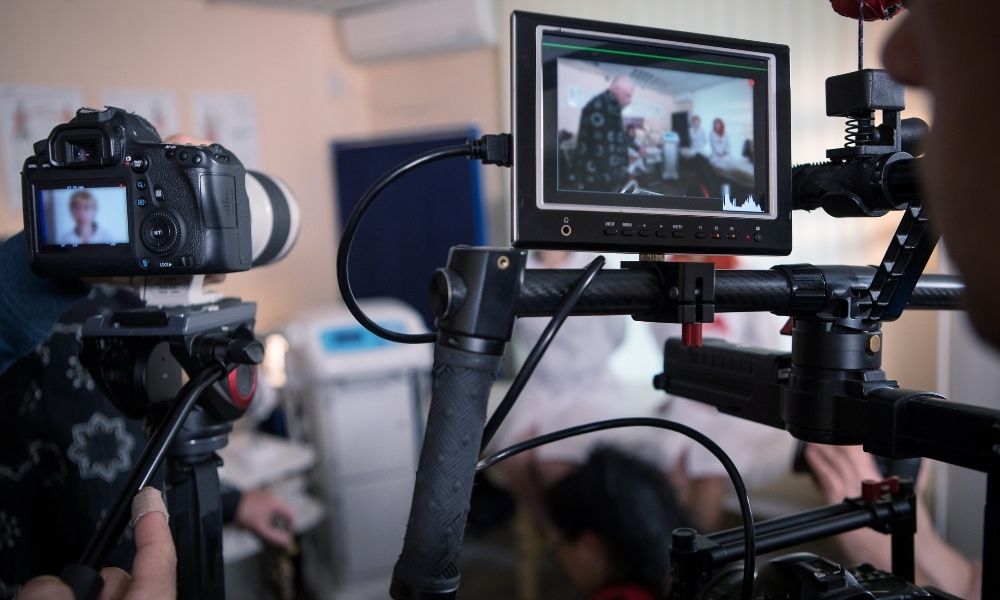Shooting high-quality videos doesn’t always require expensive equipment or advanced skills, but understanding the basics and using the right techniques can make a huge difference. Whether you’re filming for YouTube, social media, or personal projects, these essential tips will help you create professional-looking content.
1. Use Good Lighting
Lighting is one of the most important factors for high-quality video production. Natural light works well, but if you’re filming indoors, you may need additional lighting. The key is to ensure your subject is well-lit, with soft, even light that doesn’t cause harsh shadows.
-
Natural Light: If filming during the day, position yourself near a window to take advantage of natural light.
-
Soft Lighting: Use softbox lights or ring lights to diffuse light and avoid harsh shadows.
-
Avoid Backlighting: Make sure the light source is in front of you, not behind, to prevent the subject from looking too dark.
Tip: For more professional lighting, consider a three-point lighting setup (key light, fill light, and backlight).
2. Stabilize Your Camera
Shaky footage can ruin the quality of your video. Use a tripod, gimbal, or any stabilization tool to keep your camera steady and avoid jerky movements. Even if you’re shooting handheld, try to keep your arms steady, and move slowly to maintain a smooth shot.
-
Tripod: A tripod is a must for stable shots.
-
Gimbal: If you’re moving while filming, a gimbal helps keep the camera steady.
-
Post-Production Stabilization: Some video editing software, like Adobe Premiere or Final Cut Pro, has tools to stabilize shaky footage.
Tip: Avoid zooming in and out quickly, as it can cause your footage to feel unstable.

3. Set the Right Frame Rate and Resolution
Choosing the correct frame rate and resolution will help you achieve the desired look for your video.
-
Resolution: Shoot in at least 1080p (Full HD) for clear, crisp visuals. If possible, go for 4K for the highest quality.
-
Frame Rate: For regular video, 24fps (frames per second) gives a cinematic look. If you want to create slow-motion effects, shoot at higher frame rates, like 60fps or 120fps.
Tip: Keep in mind that higher resolution and frame rates require more storage space, so make sure you have enough memory and processing power.
4. Focus on Composition
The composition of your shot makes a huge impact on the overall quality of your video. Make sure your subject is framed well and avoid unnecessary distractions in the background. Use the “rule of thirds” to position your subject in the frame.
-
Rule of Thirds: Imagine your frame divided into nine equal parts using two horizontal and two vertical lines. Place your subject where the lines intersect to create a balanced and aesthetically pleasing shot.
-
Background: Keep the background simple and uncluttered. Avoid distracting elements that may take attention away from the subject.
Tip: Use a shallow depth of field (wide aperture) to blur the background and focus on your subject.
5. Choose the Right Camera Settings
Knowing how to adjust your camera settings is essential for capturing high-quality footage.
-
ISO: Set your ISO to the lowest possible value without making your video too dark. A higher ISO can introduce noise (grain) into your footage.
-
Shutter Speed: Use a shutter speed that’s double your frame rate for natural motion blur (e.g., if filming at 24fps, use a shutter speed of 1/50).
-
Aperture: Set the aperture to control how much light enters the camera. A wider aperture (lower f-number) creates a blurred background, while a smaller aperture (higher f-number) keeps more of the scene in focus.
Tip: Check your camera’s white balance settings to ensure accurate colors and avoid unnatural hues.
6. Capture Clear Audio
Good audio is just as important as good video. Poor sound quality can make even the most visually stunning video feel unprofessional. Invest in a good microphone, and make sure to monitor the audio levels during filming.
-
External Microphone: Built-in microphones often pick up unwanted noise. A shotgun mic or lapel mic will capture clearer, more focused audio.
-
Audio Levels: Monitor the audio during filming to ensure it’s not too loud (which can cause distortion) or too soft.
-
Post-Production: You can improve audio in post-production by reducing background noise and adjusting levels.
Tip: Always record in a quiet environment, or use soundproofing tools to minimize external noise.
7. Plan Your Shots
Planning your shots in advance will save you time during filming and ensure you capture everything you need. Storyboarding or creating a shot list is an excellent way to stay organized.
-
Shot List: Make a list of the different shots you want to capture. This will help you stay focused and efficient during filming.
-
Rehearse: Practice your shots before you start filming to ensure everything looks good and runs smoothly.
Tip: Don’t be afraid to experiment with different angles and camera movements to add variety to your video.
8. Use Color Grading for Professional Touch
Color grading can elevate the look of your video and make it feel more polished. In post-production, use color correction to adjust the exposure, white balance, and color tones. You can then apply a color grade to give your video a cinematic or unique look.
-
Software: Use editing software like Adobe Premiere Pro, DaVinci Resolve, or Final Cut Pro for color grading.
-
Color Profiles: Use flatter color profiles (like LOG or flat) while filming to give you more flexibility in grading.
Tip: Be careful not to overdo the color grading. Aim for a natural yet stylized look that enhances your video.
9. Edit for Flow and Pacing
After shooting, editing is where your video truly comes to life. Trim unnecessary footage, add transitions, adjust audio levels, and ensure the video flows smoothly.
-
Cutting: Remove any mistakes or unnecessary footage that doesn’t add to the story.
-
Transitions: Use smooth transitions between clips to maintain a natural flow.
-
Music and Sound Effects: Background music and sound effects can enhance the mood of your video, but make sure they don’t overpower the dialogue.
Tip: Keep your edits clean and simple. Overuse of effects can distract from the main message of your video.
Conclusion
Creating high-quality videos doesn’t have to be complicated. With the right techniques and tools, you can elevate your content and achieve professional-looking results. Focus on good lighting, steady camera work, thoughtful composition, and clear audio, and your videos will stand out. Keep practicing and experimenting, and with time, your video production skills will continue to improve.










